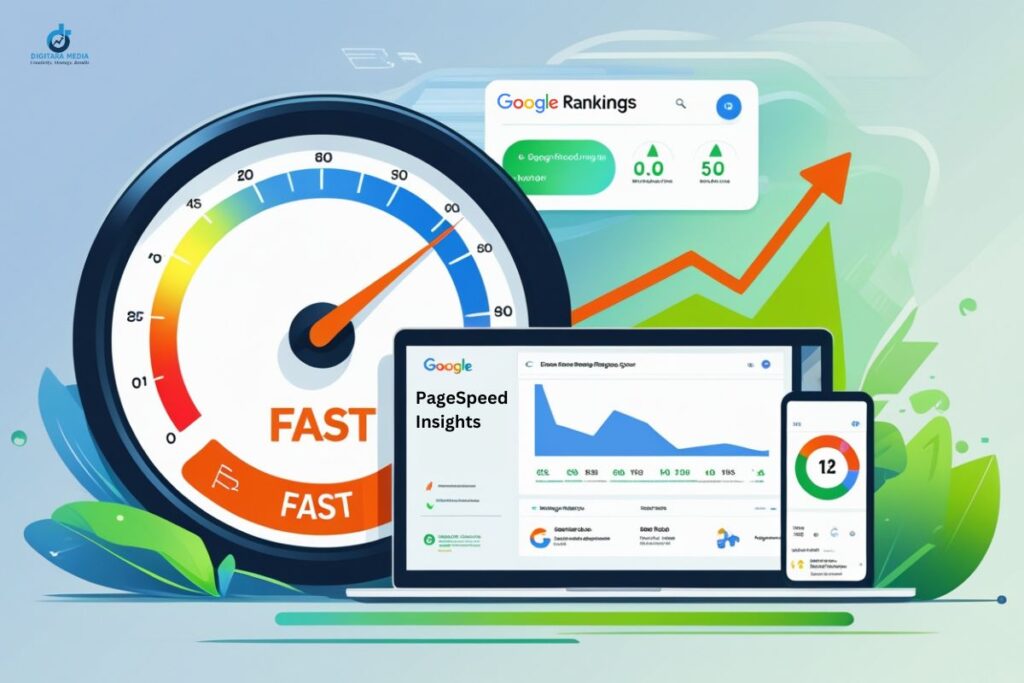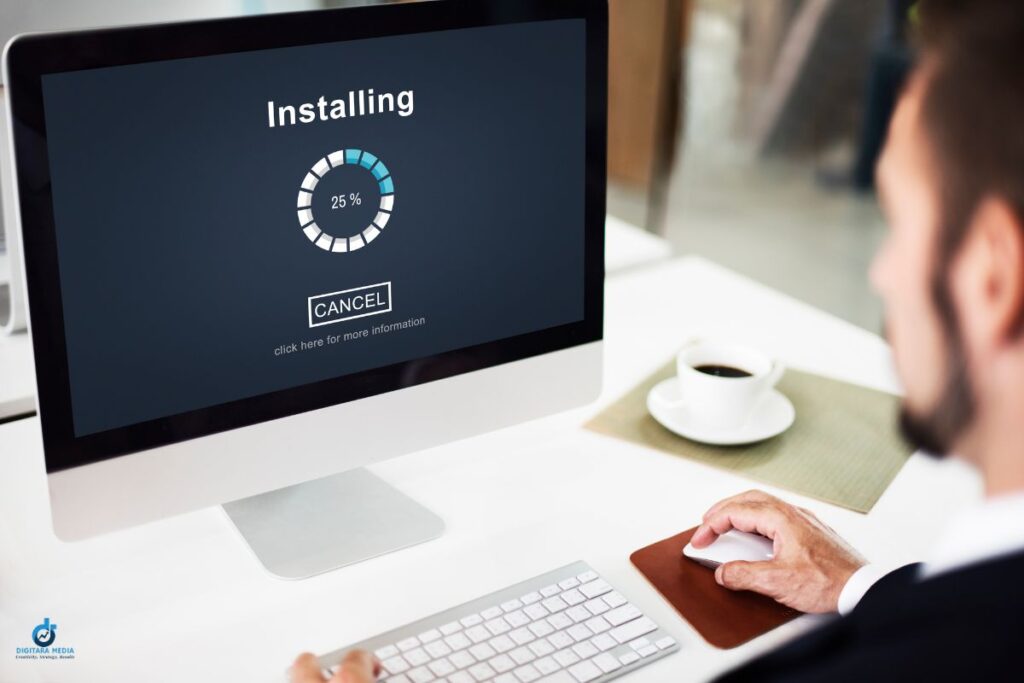Website speed is one of the most critical factors influencing search engine rankings and user experience. A slow website not only frustrates visitors but also leads to higher bounce rates and lower conversion rates.
Google has officially made page speed a ranking factor, meaning slow websites may struggle to rank on the first page of search results. But why does website speed matter so much? Because Google wants users to have a smooth, fast browsing experience.
In this article, we’ll explore why website speed is crucial for rankings, how it affects SEO, and practical ways to improve your site’s performance.
Understanding Website Speed and Core Web Vitals
What is Website Speed?
Website speed refers to how quickly a website loads and displays its content to users. Faster websites provide a better experience, keeping users engaged and reducing bounce rates.
What are Core Web Vitals?
Core Web Vitals are a set of metrics that measure website speed and user experience. Google considers these factors essential for ranking:
- Largest Contentful Paint (LCP) – Measures loading performance (should be under 2.5 seconds).
- First Input Delay (FID) – Measures interactivity (should be under 100ms).
- Cumulative Layout Shift (CLS) – Measures visual stability (should be under 0.1).
How Core Web Vitals Affect SEO Rankings
Websites that perform well in Core Web Vitals tests have a higher chance of ranking on Google. Pages that load slowly or shift unexpectedly while loading can be penalized in search rankings.
Google’s Page Experience Update and Its Impact
Google’s Page Experience Update emphasizes how a website’s speed and user-friendliness impact its rankings. If your website is slow, it creates a poor experience, leading to lower rankings.
Why Speed is a Major Ranking Factor
Google prioritizes websites that load quickly and efficiently because:
- Slow websites frustrate users, increasing bounce rates.
- Faster websites keep visitors engaged, improving dwell time.
- A seamless experience encourages users to return, improving search rankings.
How This Update Affects Slow-Loading Websites
If a website does not meet Google’s page experience standards, it may:
- Drop in rankings, even if the content is high-quality.
- Lose organic traffic to faster competitors.
- Experience lower conversion rates due to poor user experience.
How Website Speed Affects User Experience (UX)
Website speed plays a direct role in user experience (UX). Google measures UX by analyzing how visitors interact with a site.
Importance of Fast-Loading Pages for Engagement
- Pages that load in under 2 seconds have lower bounce rates.
- A fast website encourages users to explore multiple pages.
- Slow sites lead to frustration and drop-offs.
How Slow Websites Increase Bounce Rates
Bounce rate measures how many visitors leave a page without taking any action. If a website takes too long to load, users are more likely to exit.
- 1-second delay in load time = 7% drop in conversions.
- 3-second delay = 50% of visitors leave the page.
The Impact of Speed on Mobile Users
Since more than 60% of Google searches happen on mobile, speed is even more critical.
- Slow mobile sites have higher abandonment rates.
- Mobile users expect instant page loads due to limited data and network speed.
Mobile-First Indexing and Speed Optimization
Google’s Mobile-First Indexing means it ranks websites based on their mobile versions first. If your site isn’t mobile-optimized, it will rank lower.
Importance of Speed Optimization for Mobile Users
- Mobile users often have slower internet speeds than desktops.
- Google prioritizes mobile-friendly websites in search results.
- Mobile-friendly, fast websites attract more organic traffic.
Best Practices for Mobile Speed Improvements
✅ Use Responsive Design – Ensures the site adjusts to different screen sizes.
✅ Reduce Image Sizes – Compress images for faster loading.
✅ Enable AMP (Accelerated Mobile Pages) – Improves mobile performance.
✅ Minimize Redirects – Reduces the time it takes for a page to load.
Technical SEO for Speed Optimization
Importance of Technical SEO in Website Speed
Technical SEO helps optimize a website’s structure for better performance. Google crawls fast websites efficiently, leading to improved indexing and rankings.
How to Improve Server Response Time
A slow server delays website loading. Fix this by:
- Choosing a reliable hosting provider.
- Using a lightweight CMS (e.g., WordPress with optimized themes).
- Reducing database queries to avoid unnecessary server requests.
Optimizing Website Caching for Faster Performance
Caching stores frequently accessed website elements, improving loading times.
- Enable browser caching to store site data on users’ devices.
- Use a caching plugin for WordPress, like WP Rocket or W3 Total Cache.
Image Optimization for Faster Load Time
Images are often the largest elements on a webpage, affecting load times.
Role of Images in Website Speed
- Unoptimized images can make pages 50% slower.
- Google favors pages with compressed, optimized images.
Best Practices for Image Compression
✅ Use Next-Gen Formats – WebP and AVIF offer better compression than JPEG/PNG.
✅ Resize Images – Use exact dimensions rather than large images scaled down via CSS.
✅ Use Lazy Loading – Loads images only when users scroll down.
Minifying CSS, JavaScript, and HTML
How Bloated Code Slows Down Websites
- Unnecessary spaces, line breaks, and comments make code heavy.
- Large JavaScript files delay rendering, making websites sluggish.
Best Tools for Minification
- Google PageSpeed Insights – Analyzes page speed and provides suggestions.
- GTmetrix – Provides performance reports and recommendations.
- CSSNano & UglifyJS – Minify CSS and JavaScript files efficiently.
Benefits of Reducing Unnecessary Scripts
✅ Faster Load Time – Reduces file sizes, making sites load quicker.
✅ Better SEO – Google rewards efficient coding with higher rankings.
✅ Improved User Experience – Faster interactions enhance usability.
The Role of a Content Delivery Network (CDN)
What is a CDN and How It Works?
A Content Delivery Network (CDN) is a network of global servers that store website copies to deliver content faster.
How a CDN Improves Website Speed
- Reduces Latency – Delivers content from the closest server.
- Minimizes Server Load – Balances traffic across multiple locations.
- Increases Page Load Speed – Helps global users access the site faster.
Best CDN Providers for Better Performance
- Cloudflare – Free and premium plans for faster site delivery.
- Amazon CloudFront – Enterprise-level CDN service.
- Akamai – Excellent for high-traffic websites.
Website Hosting and Server Performance
How Hosting Affects Website Speed
- Cheap, shared hosting often slows down websites.
- Fast, dedicated servers provide consistent performance.
Shared vs. Dedicated Hosting: Which is Better?
| Hosting Type | Pros | Cons |
| Shared Hosting | Affordable | Slower during high traffic |
| Dedicated Hosting | Faster, more reliable | Expensive |
| Cloud Hosting | Scalable & cost-effective | Requires setup |
Choosing a High-Performance Hosting Provider
✅ Look for SSD (Solid-State Drive) storage.
✅ Select a host with a 99.9% uptime guarantee.
✅ Ensure the provider supports caching and CDN integration.
Lazy Loading for Better Speed Performance
What is Lazy Loading?
Lazy loading delays loading images, videos, or scripts until they’re needed, reducing initial load times.
How Lazy Loading Improves Page Load Time
- Speeds up first-page load time by loading only visible content.
- Reduces data usage, especially for mobile users.
Best Practices for Implementing Lazy Loading
✅ Use “loading=lazy” attribute in HTML.
✅ Enable lazy loading in WordPress or Shopify.
✅ Use plugins like Lazy Load by WP Rocket.
Measuring and Monitoring Website Speed
Best Tools to Measure Website Speed
- Google PageSpeed Insights – Analyzes mobile & desktop speeds.
- GTmetrix – Provides detailed page speed reports.
- Lighthouse – A Google tool for performance audits.
Setting Up Regular Speed Monitoring
- Schedule weekly speed tests to check performance.
- Track Core Web Vitals for ongoing optimization.
- Use performance monitoring tools like Pingdom.
Conclusion
Website speed is crucial for Google rankings and user satisfaction. Slow sites lead to higher bounce rates, lower conversions, and poor search rankings. By optimizing speed through image compression, caching, CDNs, and technical SEO, you can boost both SEO and user experience.
If you want to rank higher on Google, prioritize website speed today! 🚀
FAQs
What is a good website loading speed for SEO?
Google recommends a loading speed of under 2.5 seconds for the best rankings.
How can I test my website speed?
Use Google PageSpeed Insights, GTmetrix, or Lighthouse to analyze and improve speed.
Does website speed affect mobile rankings?
Yes! Google uses Mobile-First Indexing, meaning slow mobile sites rank lower.
Can plugins slow down my website?
Yes. Too many plugins increase load time. Use only essential, lightweight plugins.
How often should I optimize website speed?
Speed optimization should be ongoing, with monthly checks using speed tools.


